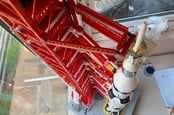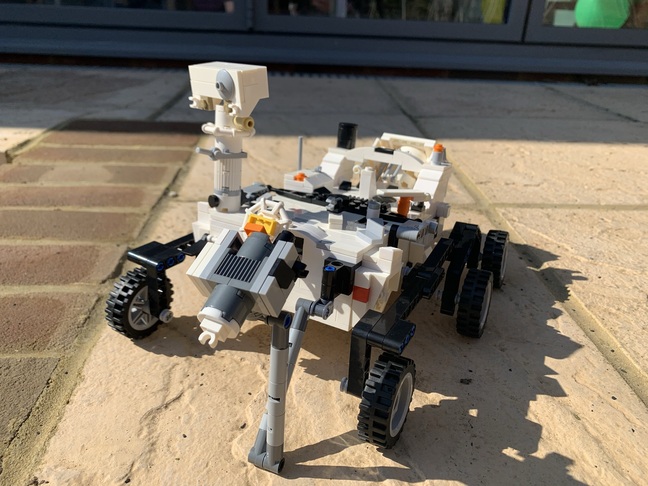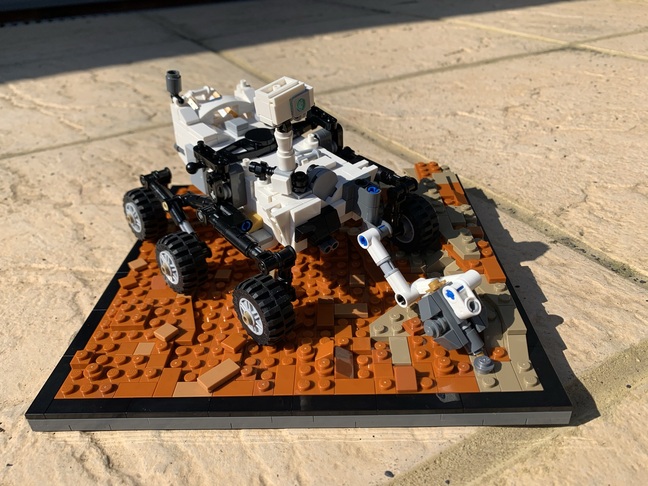This article is more than 1 year old
NASA's Perseverance rover in brick form: China set vs unofficial Lego fan design
The Register goes a-building once more – no glue required this time
NASA's Perseverance is currently trundling around Mars. In the absence of an official Lego version, your hardworking vultures had a crack at a pair of recent designs for the nuclear-powered rover.
We have a bit of a chequered history when it comes to the plastic bricks. Sure, we had fun building the International Space Station and Apollo Lunar Module, but those were genuine kits containing genuine Lego bricks.
Our other excursions were less successful. The crawler transporter for the Saturn V launch tower was a bit of a beast and the less said about the launch tower itself the better. (Glue. Glue.)
But Perseverance's successful landing has given us the construction itch once again. We missed the boat when Curiosity was all the rage (although remain tempted by the Descent Stage and Sky Crane in the Lego Ideas model) so opted to try the model retailing at $43.99 from Vonado.
To be clear, this is not an official set by any stretch of the imagination, nor is it made of official Lego parts. Like our crawler and tower, the 661-brick beast comes direct from a vendor in China.
As a comparison, we also picked up a design from SkylabBricks, which cost us £4.52. (Although one must supply one's own bricks. More on that later.)
We started with the Vonado model, the design and modelling of which is credited to YCBricks (you can pick up just the PDF instructions for $6.99 at Rebrickable.)
Compared to the pain of the Saturn tower, the build was relatively straightforward, although we'd have to caution that skipping ahead in the PDF instruction file is highly advisable since some steps aren't particularly clear.
The bags of parts come numbered, although as with the crawler, those numbers have no bearing on what is needed when. More than one leap of faith was needed, to the point where one couldn't help but wonder if anybody had actually tried to follow the steps before flinging the kit up for sale.
That said, the resulting rover was satisfyingly large even if its proportions seemed subjectively a little at odds with its inspiration. It does, however, feel a little fragile and not something that one would want to handle too much, which is a shame. One benefit of models like the Saturn V and Apollo lander is the ease with which one can use them to explain how spacecraft work. Not so much with this.
The SkylabBricks version was an entirely different beast. The cost of a London pint of beer gave one a link to PDFs detailing how to make the rover and Martian landscape. Parts files are provided to submit to the Bricklink site for ordering up components and spending, as Joe Chambers of SkylabBricks succinctly put it, "lots of money."
This is most definitely not the cheap option. The plans are helpfully split into rover and surface, but doing both with new Lego parts will come in at about £90 depending on the vagaries of the Bricklink marketplace (and what you already have in stock).
Cost of parts aside, the PDF instructions from SkylabBricks are streets ahead of those for the Vonado rover. As well as the expected step-by-step assembly instructions, a good few pages are dedicated to documenting the rover itself, its mission, payload, and the Ingenuity helicopter.
The instructions also give a nod to Lego's original (and discontinued) Curiosity set, although this is considerably more detailed. It also comes in at 323 pieces for the rover and 370 for the display stand.
As for those pieces, we used the Bricklink site and the .xml parts files supplied by SkylabBricks. We allowed Bricklink to select the stores to supply the bricks (from a variety of geographical locations, including the UK, Europe, the US, and Malaysia). Over the course of a couple of weeks, little parcels of Lego joy arrived.

We bought a knockoff Lego launchpad kit from China for our Saturn V rocket so you don't have to
READ MOREAs with the Vonado rover, the packaging of the parts had no bearing on the order of assembly. However, since careful auditing was needed to ensure what was delivered was what had been ordered, putting together the SkylabBricks rover was a good deal easier (although we can understand why one might want to have one's bricks arrive in one, big package).
The difference between the rovers is surprising. While smaller, the SkylabBricks version is considerably more "play-with-able" and feels a good deal more solid. Bits did not fall off when a small child decided to take it for a spin over an imagined Martian surface consisting of dirt, gravel, and a lichen-encrusted paving slab. Parts dropped from the Vonado version just moving it from shelf to shelf (and resulted in more than one glance at the dread bottle of glue).
The Lego recreation of the surface of Mars was also a hoot to assemble, and made for a handy display stand.
The Register spoke to SkylabBricks' Joe Chambers about the designs and the effort involved. Each design takes between three to four months, depending on the size of the project. "My instructions," he said, "are somewhat unique in that I do a technical writeup of the subject and put it into the PDF.
"That is more for me, to be honest, but sometimes that takes a couple of weeks alone. I overdid it on my Delta IV, I must admit, writing something about all seven versions, but I love the stories and the technology of these things.
"The main focus of my designs, if you haven't noticed, is space exploration and rocketry. I design things that I like or that I want to display.
"For lack of a better description, I make models of things through the design constraint of Lego. I may be weird in that I want to make something look as accurate to the real thing that Lego will allow. I even try to hide studs behind tiles as much as possible. I am not building with mini-figs in mind or that it will be a playset. With all respect to people who enjoy that, my mindset is 100 per cent on the side of form over function, and, sometimes, over structural integrity."
We can, however, confirm that the Perseverance model is excellent for playing with as well as being impressively detailed. The cost of assembling all the parts when compared to the alternative might however be a bit much for some.
As the name implies, a Skylab design can also be picked up from the SkylabBricks site. After this week's announcement of a new official Lego Space Shuttle set, Chambers mused: "It suddenly hit me that it is about the same scale as my big Skylab. Ever hear of the Skylab Rescue mission? I think that might be a quick one to do..."
If only NASA had been able to do the same. ®



